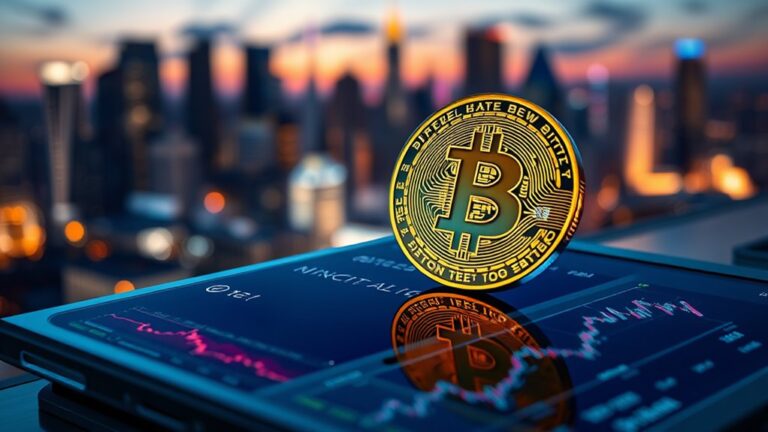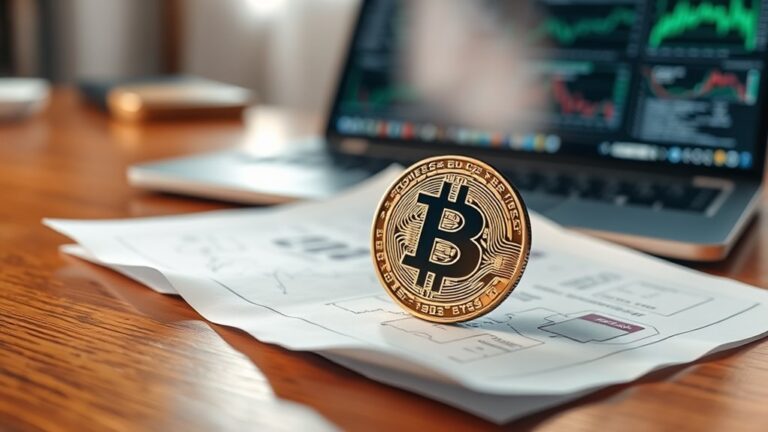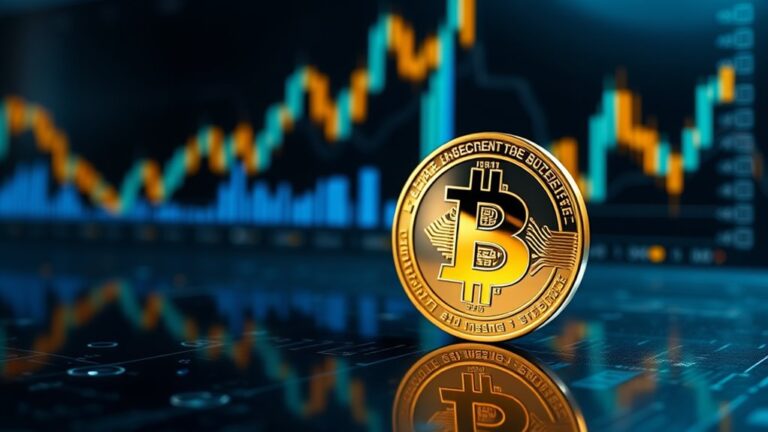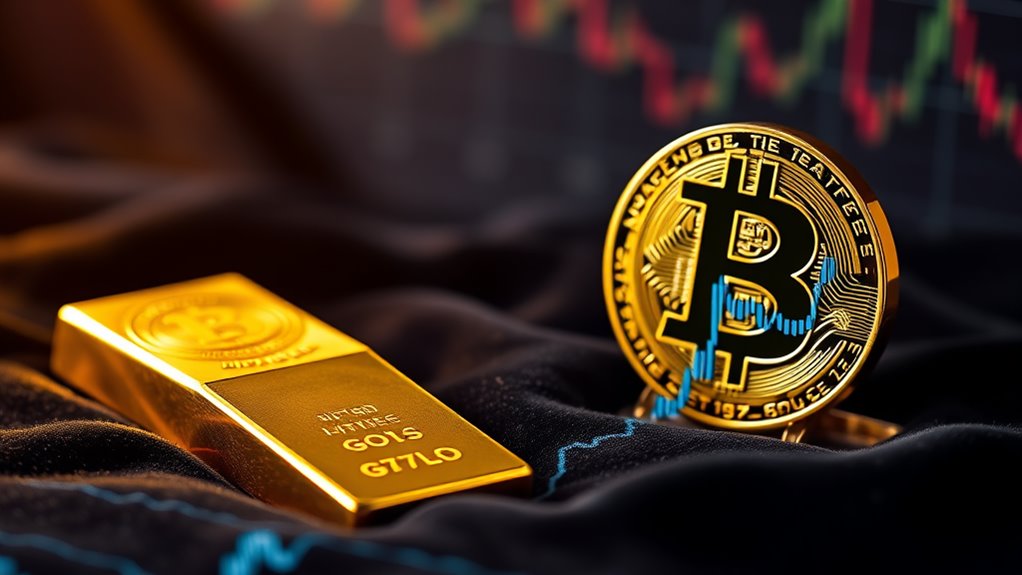
Bitcoin Vs Gold: Which Offers Better Value in 2025?
Bitcoin offers higher growth potential with its 78% average annual returns over the past decade, while gold provides stability with consistent 10% returns. Bitcoin's fixed supply of 21 million coins creates programmatic scarcity, whereas gold maintains natural scarcity with steady 1.5-2% annual supply increases. Investors seeking aggressive growth might prefer Bitcoin, while those prioritizing wealth preservation may choose gold. The ideal strategy likely involves allocating portions to both assets, balancing risk and reward. Further exploration reveals strategic advantages for each investment.
Key Takeaways
- Bitcoin's historical 78% CAGR versus gold's 10% suggests stronger growth potential through 2025, despite higher volatility.
- Gold offers stability during economic uncertainty, while Bitcoin provides greater upside potential in diversified portfolios.
- Bitcoin's predetermined halving schedule creates predictable supply reduction events, potentially driving price appreciation more dramatically than gold by 2025.
- Institutional adoption through regulated crypto vehicles is increasing Bitcoin's legitimacy, narrowing the perception gap with gold as a store of value.
- Evolving regulatory frameworks will significantly impact both assets by 2025, with Bitcoin facing higher regulatory uncertainty but greater innovation potential.
The Evolution of Value: Gold's Ancient Appeal vs. Bitcoin's Digital Promise

While gold has maintained its status as a premier store of value for thousands of years, Bitcoin has emerged as a digital alternative that challenges traditional concepts of wealth preservation. Gold's timeless appeal stems from its physical properties and inherent industrial value, offering stability during economic turmoil. Central banks worldwide continue to hold gold reserves, indicating persistent trust in this ancient asset.
In contrast, Bitcoin represents financial innovation, leveraging blockchain technology to create digital scarcity with its capped supply of 21 million coins. Its evolution continues through developments like the Lightning Network, enhancing usability and accessibility.
Demographic shifts also favor Bitcoin, as younger investors increasingly prefer digital assets. Despite regulatory uncertainties, Bitcoin's portability, divisibility, and global accessibility provide advantages that physical gold cannot match, potentially reshaping value storage paradigms for future generations. The growing institutional adoption of Bitcoin signals its transition from a niche digital asset to a recognized store of value in the global financial landscape.
Analyzing Historical Performance Patterns of Gold and Bitcoin

The examination of historical performance data offers compelling insights into the financial trajectories of both Bitcoin and gold.
Bitcoin has demonstrated remarkable growth, achieving a +121,013% return over 12 years compared to gold's more modest +88% during the same period. Bitcoin's CAGR of approximately 78% over the past decade considerably outpaces gold's average of 10%.
While gold offers steady gains, Bitcoin's explosive 121,013% twelve-year return dwarfs traditional assets with extraordinary growth potential.
However, these impressive returns come with notable volatility. Bitcoin's price cycles feature dramatic swings tied to halving events, with phases of rapid growth followed by steep corrections.
Gold, in contrast, provides relative stability and consistent performance. This fundamental difference explains why Bitcoin attracts younger investors seeking high returns, while gold appeals to those prioritizing wealth preservation and stability in their investment portfolios.
These historical patterns have been shaped by numerous market indicators including regulatory developments, technological innovations, and broader adoption events that continue to influence Bitcoin's price trajectory.
Scarcity Economics: Comparing the Limited Supply Models

While gold derives its scarcity from geological limitations and extraction challenges, Bitcoin's scarcity stems from its programmatically fixed maximum supply of 21 million units.
This fundamental difference creates two distinct scarcity models: gold's supply increases at a slow, unpredictable rate dependent on mining operations, whereas Bitcoin follows a predetermined diminishing issuance schedule through halving events.
As both assets approach 2025, these contrasting scarcity mechanisms will likely influence their respective market behaviors, with Bitcoin's transparent supply ceiling potentially creating different value dynamics than gold's naturally constrained but less predictable availability.
Bitcoin's role as a peer-to-peer system without intermediaries further distinguishes its scarcity model from gold, which typically requires third parties for verification and custody.
Rarity vs. Finite Digits
Fundamental differences between Bitcoin's digital scarcity and gold's physical rarity create distinct value propositions for investors seeking hedge assets.
While gold derives its value from natural scarcity and extraction costs, Bitcoin's value stems from a mathematically enforced cap of 21 million coins. This programmatic limitation contrasts with gold's physical constraints.
- Gold offers stability through thousands of years of market history and physical tangibility
- Bitcoin provides transparent supply metrics with predictable halving events
- Market volatility differs greatly, with Bitcoin showing higher price fluctuations
- Investor perception varies between the "digital gold" narrative and traditional precious metal stability
Both assets leverage scarcity principles but through fundamentally different mechanisms, creating complementary options for investors based on their risk tolerance and investment timeline.
Unlike gold, Bitcoin exists in an ecosystem with thousands of alternative digital assets that compete for investor attention and offer different technological innovations beyond store-of-value functions.
Diminishing Supply Effects
Scarcity economics reveals two distinctly different trajectories for Bitcoin and gold as they approach 2025, despite both assets relying on limited supply models.
While gold's supply increases gradually at 1.5-2% annually through mining, Bitcoin follows a programmed path of diminishing returns with its halving events occurring every four years.
This fundamental difference creates divergent value propositions. As Bitcoin approaches its 21 million coin cap, each halving event further restricts new supply, potentially amplifying price sensitivity to demand fluctuations.
Gold, with its steady but limited growth rate, offers more predictable scarcity.
The diminishing supply of Bitcoin may attract investors seeking protection against inflation, similar to gold's traditional role.
However, Bitcoin's predetermined scarcity contrasts with gold's natural limitations, presenting investors with distinct considerations regarding long-term value retention.
Bitcoin's halving cycles have historically correlated with significant price increases as the reduction in mining rewards creates enhanced scarcity while demand continues to grow.
Risk Assessment: Volatility Factors and Investment Security

When comparing Bitcoin and gold as investment vehicles, understanding their distinct risk profiles becomes essential for informed decision-making.
Bitcoin exhibits markedly higher volatility due to several structural factors, while gold offers historical consistency that appeals to risk-averse investors.
- Bitcoin's price sensitivity stems from market sentiment, regulatory developments, and the relatively low liquidity of cryptocurrency markets.
- Gold maintains stability through established market depth, consistent demand patterns, and lower susceptibility to regulatory influences.
- Macroeconomic factors affect both assets differently—Bitcoin often experiences amplified reactions while gold demonstrates more measured responses.
- Investment security varies considerably, with Bitcoin facing technological risks and regulatory uncertainty while gold contends primarily with storage concerns and modest growth potential.
These fundamental differences in volatility characteristics will likely persist through 2025, requiring investors to align their risk tolerance accordingly.
Contrary to popular misconception, Bitcoin is not a Ponzi scheme but rather a decentralized digital currency with transparent technology and real utility value.
Portfolio Diversification Strategies Using Gold and Bitcoin
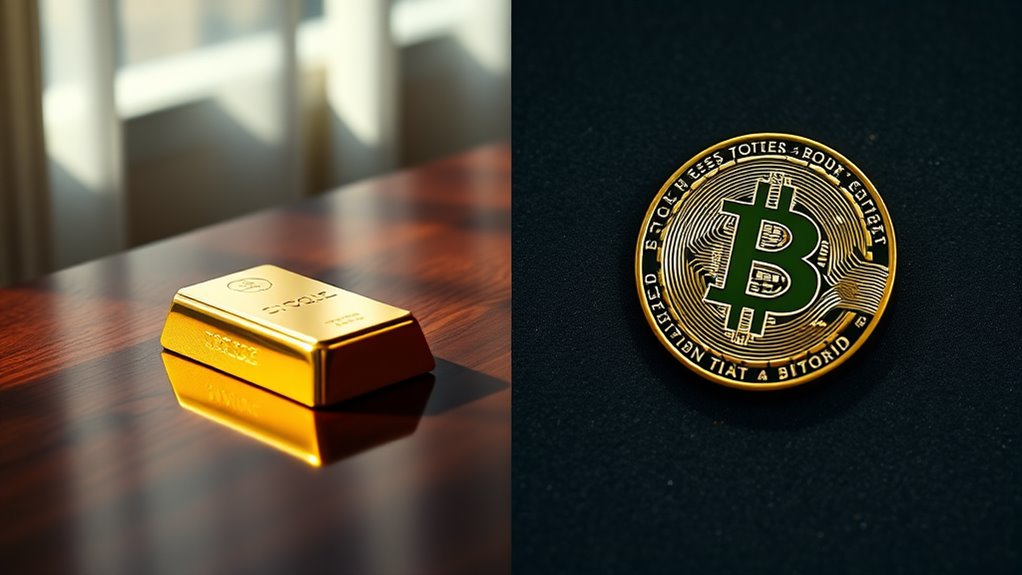
How investors structure their portfolios in volatile markets can greatly impact long-term financial outcomes, making the strategic combination of Bitcoin and gold increasingly relevant in modern investment approaches.
Financial experts recommend a balanced allocation approach, typically suggesting 5-10% of portfolios in gold and a smaller position in Bitcoin to reflect its higher volatility profile.
This combination leverages the complementary nature of both assets: gold provides stability during economic uncertainty, while Bitcoin offers growth potential. Their low correlation with traditional investments like stocks and bonds enhances overall portfolio resilience.
Institutional investors increasingly recognize this value proposition, gradually increasing allocations to both assets.
For effective implementation, investors should consider their risk tolerance, investment timeline, and regulatory environment, which varies considerably between these asset classes.
The growing clarity in regulatory frameworks for cryptocurrencies expected through 2025 will significantly impact how investors balance these assets in their diversification strategies.
Technological Advantages of Bitcoin in a Digital Economy
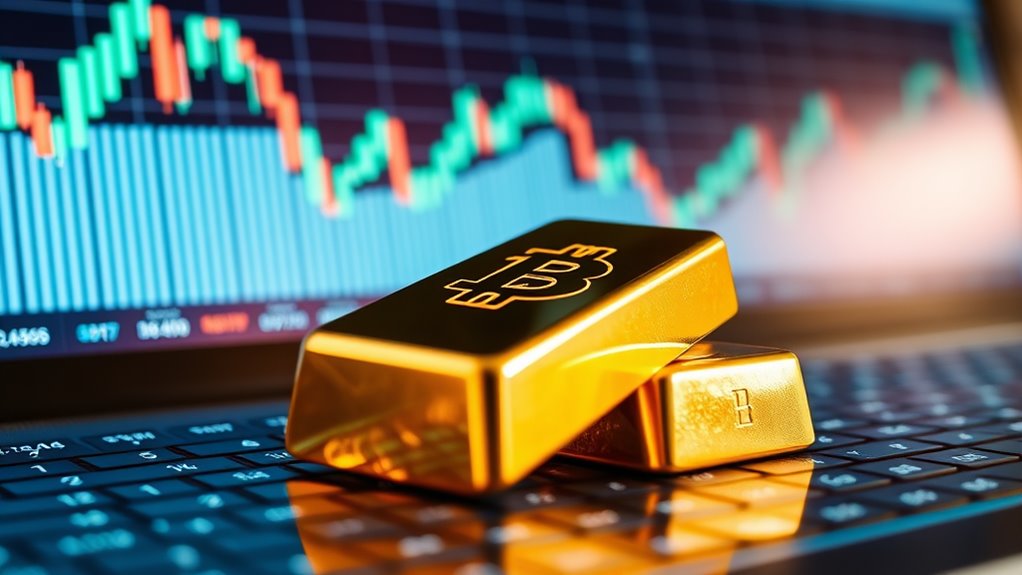
Beyond their role in portfolio diversification, digital assets like Bitcoin offer distinct technological advantages that position them uniquely in our increasingly digital economy. The blockchain infrastructure underlying Bitcoin enables secure, transparent transactions without traditional intermediaries, fundamentally changing how value transfers occur in digital spaces.
- Bitcoin's decentralized structure provides resistance to censorship and government control, offering autonomy traditional assets cannot match.
- Transaction processing times outpace conventional banking systems, especially with innovations like the Lightning Network.
- Lower operational costs benefit businesses, with reports showing up to 37% increases in efficiency.
- Blockchain technology guarantees transaction transparency and verification, greatly reducing fraud risks.
These technological capabilities make Bitcoin particularly suited to an increasingly digital global economy where speed, security, and efficiency are paramount considerations. The Lightning Network protocol allows users to conduct near-instant Bitcoin transactions with minimal fees by establishing payment channels that operate separately from the main blockchain.
Regulatory Landscape and Its Impact on Both Assets by 2025

The regulatory frameworks governing Bitcoin and gold will likely determine their respective values and adoption rates by 2025, with significant implications for investors and markets worldwide.
Gold continues to benefit from centuries of established regulations, providing stability and predictability for investors.
In contrast, Bitcoin's regulatory environment is rapidly evolving, with jurisdictions developing varying approaches to cryptocurrency governance.
The challenge for policymakers remains striking the right balance of oversight between protecting consumers and enabling the innovative potential of digital assets without stifling technological advancement.
Institutional Adoption Trends and Their Effect on Market Value

While regulatory frameworks shape the legal foundation for both assets, institutional adoption ultimately drives market value through large-scale capital deployment.
In 2025, institutions increasingly view cryptocurrencies as legitimate investments alongside traditional safe-haven assets like gold. This shift has contributed to Bitcoin reaching historic highs, while stabilizing some of its notorious volatility through consistent capital inflows.
- Regulated crypto investment vehicles have proliferated, enabling traditional financial institutions to gain exposure.
- Institutional capital has enhanced Bitcoin's market legitimacy, improving public perception and adoption.
- Advanced custody solutions and trading platforms have addressed security concerns that previously deterred institutional involvement.
- Portfolio diversification strategies now commonly include both gold and Bitcoin, serving complementary roles in risk management.
Investors should understand that regional compliance measures vary significantly between jurisdictions, with some nations embracing cryptocurrency innovation while others impose strict limitations.
Frequently Asked Questions
How Does Environmental Impact Compare Between Gold Mining and Bitcoin Mining?
Gold mining typically consumes more total energy than Bitcoin mining but causes additional environmental impacts like deforestation and water pollution. Bitcoin mining produces significant carbon emissions but increasingly utilizes renewable energy sources.
Can Bitcoin Replace Gold as a Global Currency Reserve?
Like fire meeting ice, Bitcoin challenges gold's reserve status. While Bitcoin offers technological advantages and limited supply, its volatility remains a significant barrier. Traditional gold continues to anchor central bank reserves through proven stability.
How Do Transaction Fees Compare When Investing in Gold Versus Bitcoin?
Bitcoin transaction fees vary based on network congestion and can spike markedly, while gold typically incurs stable fees related to physical storage, insurance, and dealer premiums rather than the transaction itself.
Will Quantum Computing Pose a Threat to Bitcoin's Security?
Quantum computing could eventually threaten Bitcoin's security by breaking its cryptographic foundations, but practical threats remain distant. The Bitcoin community is actively developing quantum-resistant algorithms as potential solutions to this future vulnerability.
How Do Inheritance and Estate Planning Differ for Gold and Bitcoin?
As dusk falls on one's financial legacy, the paths diverge dramatically. Gold inheritance leverages established legal frameworks with physical simplicity, while Bitcoin requires meticulous digital access planning amid evolving regulatory landscapes and complex security considerations.
Conclusion
As 2025 approaches, both gold and Bitcoin stand as lighthouses in the turbulent sea of investment options. While gold continues to anchor portfolios with its time-tested stability, Bitcoin navigates toward potentially greater horizons with technological tailwinds. Investors must chart their course based on risk tolerance, regulatory developments, and portfolio needs—recognizing that these assets can coexist in a balanced investment strategy rather than compete in a winner-take-all race.




